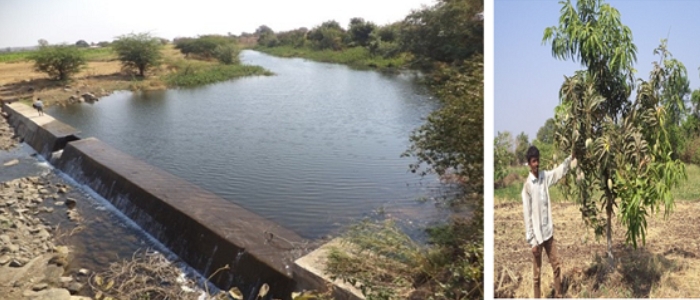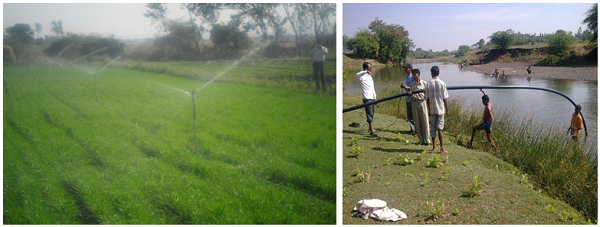Making water ‘Every One’s’ Business
Total Views |
-Kapil Sahasrabuddhe
Transforming life
Bansilal Gavit is a marginal tribal farmer from Karanjali village, Nandurbar district. Till 2009, he used to migrate to Surat after monsoon. He used to earn 40000 per year. But in 2009, an initiative by him and his fellow farmers changed their life. He and his 5 fellow farmers came together to use water stored in cement bag bandharas constructed by the village. They used a common water lift pump. For the first time, all of them used water to irrigate their field. He diversified his agriculture from only staple crop like rice to vegetable and tree-based farming. In last 10 years, he built his house, started a new enterprise, bought new vehicle and got rid of all his debt.

Bansidada is part of Ganesh Water User Group. There were 5 members in that group. From 2009, families of this entire group have not been migrating after the monsoon. They improved their financial status. Like Bansidada, they also developed assets as per their requirement and got rid of all kinds of debts.
They were inspired and supported by local voluntary organization, Dr. Hedgewar Seva Samiti. This samiti is playing role of catalyst in about 30 villages in Navapur Tehsil, Nandurbar district. They started working in Karanjali and nearby 7 villages in 2007. The effort is continuing to bring change in all spheres of life. Samiti’s efforts have directly changed the lives of more than 1000 families. The initiative is based on Ekatma Manav Darshan, epilogue of Indian Development Philosophy given by Pandit Deendayal Upadhyay.
Why this kind of change took more than 60 years in an area which is just 25 km from District Headquarter?
Nesu river flows from Khandabar area of Navapur tehsil of Nandurbar for ages. A mid-size dam is also constructed by the government for irrigation. Still not more than 10% of land was under irrigation. The area is just 25 km from Nandurbar town. This district runs probably every government scheme in India for tribal people. Still most of the people used to migrate for 4-6 months to Gujarat. Many of them work as daily labourers in irrigated parts of the district. But nothing changed in these villages despite a river flowing in the backyard. Why? Apart from local apathy, politics, are there any root causes for this situation?
The issue goes back to independence. After independence, we adopted a large dam policy as a major source of Irrigation. As per data, we have more than 2500 large dams. There are numerous small and medium dams. We could achieve irrigation ranging from 20 to 80% of agricultural land in different states. Limitations of large dam policy was known but overlooked. In last 30-35 year, many watershed programmes started to harness, conserve, manage water resources through community participation. One can witness sporadic successful villages which could harness water and use it judiciously. Still it was not penetrating into deeper pockets and not getting enough attention from policy makers due to various reasons. The result is no irrigation available to the last person.
Another policy issue which needs special mention is the individualistic approach of schemes and programmes. We keep talking about community empowerment, mobilization and what not. Still in practice, things are very different. Most of the schemes till date are very much focused on making individual farmer independent in infrastructure development and decision making. So, a farmer in a dry area having irrigation infrastructure uses all available water without thinking what will happen to his fellow farmers. Similarly, in irrigated areas, farmers use water indiscriminately without thinking about what will happen to other fellow farmers. In last 10-15 years, we are witnessing the impact of this individualistic approach towards resource utilization. Deepening of ground water level, deterioration of soil quality & health, desertification or excess water in farm land etc. Chronic impact of individualistic approach can be seen in high rate of farmer suicide in last 15 years across country. This approach has completely destroyed our legacy of community ownership and community decision systems for resource consumption.
Cultivating change, institutionalizing use
The case of Nandurbar was no different. Areas of Tapi river basin are fertile and fully irrigated. But irrigation was not available in tribal areas. Forget about remote areas of Satpuda, even relatively flat areas nearby the district place were unirrigated. In 2007, a local organization Dr. Hedgewar Seva Samiti started discussing the issue with people in 8 villages of Khandbara area. A small river Nesu is flowing from all these villages. But not much area was irrigated and people migrated for work.

Samiti proposed to develop low cost sack dams. Local people were not very sure of this idea. It was tried earlier by officials but failed. Even efforts to build small dams went in vain due to large influx of water into the river in monsoon. Still people opted for this option. Samiti insisted that people should identify locations. It was for the first time somebody was asking people to identify dam sites. It made wonder and excellent sites were identified. Then cement bags were provided by samiti. People through shramdaan built dams using sand, soil etc. 17 bag dams were built on the river. Location selection and good quality work by people resulted in good water storage in the dams. Some people tried to break them as it was affecting fishing. But people discussed with them and the issue was resolved locally. It was an indication of success. Government soon realized potential of this people’s effort and built cement bandhara’s on same place. Local people supervised the work and also participated as labor. So they could maintain the construction quality.
Soon farmers with some water lifting pumps started using water for irrigation. But most of the farmers were poor and without any pumps. It was not possible to purchase pumps for each of them. Samiti proposed an Innovative Group Irrigation Scheme to them. The idea was to use a single water lifting device by 5-10 farmers in rotation. They should also maintain the pump. It was something out of box for people. No one has thought about such sharing. People used to get pumps on credit for some period. But never thought of a group sharing mechanism. Still after rounds of discussion they decided to try this new mechanism.
Water user groups were made. Groups made their rules, decided the O & M amount, group leaders and the planning process. They formed a timetable of sowing, calculated how much water one can get and minimum area to be irrigated using a group’s machine. It was not as simple as I wrote. It took almost 4 years to stabilize these systems.

Today after 12 year, 31 groups are functional covering 414 families and providing irrigation to 1189 acres of land in the rabbi season. In last few years, erratic rainfall has resulted in large breaks during monsoon season. Sometimes these breaks went upto 20-25 days. During such period, this irrigation infrastructure protects kharip rice crop. This is a staple crop and provides food security in the region.
Paradigm shift: private wells to community used water bodies
River and adjoining good fertile land are available with fewer people. Majority fields are away from river. Lift irrigation has limited scope due to high cost of O &M. Also, these lands are with people who are marginalized within villages. They are dependent on groundwater for irrigation. But it is also available with limited people. In this area, ground water availability issue was predominant. Majority wells used to become dry by December. So, rabbi season is a risk. Most of traditional wells are 20 to 30 ft as they were dug as per government rules. Dr. Hedgewar Seva Samiti requested Ground Water Survey and Development Agency of Government of Maharashtra to study groundwater situation. It revealed that if well deepen by 3 to 4 meters, they can reach aquifer and received good water source. This was an opportunity to work and experiment on groundwater.

Samiti proposed to support for deepening the well and the owner should provide water to 4-5 adjacent farmers. All these farmers will financially contribute in well deepening cost. I was amazed when I first learnt this idea in 2010-11. It is unthinkable in today’s individual ownership regime. Ground water is always looked as a private ownership resource if it is in private land. So, this is converting private resource in limited community resource. It took a good amount of time to settle this idea. Leaving aside all other logistics and management issues, digesting this idea was itself a challenge. Samiti and villagers worked on this idea. Today after 12 years, there are 72 well based water user groups providing water to 620 acres. 45 wells were deepened by financial support from the government and CSR. Some 27 well groups were provided with lifting pumps. It is improving the livelihood of 385 families from 8
villages.
Superimposing layers of Prosperity
Water management needs to be supported by water utilization practices. Samiti with technical support from KVK Nandurbar has promoted improved agriculture practices in traditional crops along with its seed production, processing and marketing avenues. It also supported diversification through low risk high output small plot vegetable farming and tree-based farming in the area. Innovative niche farming like onion seed production, honey production, ajwain farming is also promoted in these villages. It has directly improved the lives of 1048 families. It has stopped distress migration from these villages. Apart from these 8 villages, farmers from neighboring 30 villages are replicating different programmes implemented in these villages.

Towards path of Antyodaya
Water resource distribution and its propriety has become an international issue. Privatization of rivers is being promoted as a model for the future. But these remote, so called illiterate tribal villages have shown community way of water resource utilization. Pandit Deendayal Upadhay has advocated for local level irrigation systems against large dam-based systems and every farm should get irrigation. He clearly discussed his thinking about irrigation in Ekatma Manav Darshan, an epilogue on Indian Philosophy of Development.
There are challenges ahead in this process. As per old saying, Prosperity comes along with the devil. In the case of water, it is overuse and misuse. Also, prosperity will improve individual’s infrastructure. Thus, cooperative nature will diminish. One needs to be more cautious during prosperity. Efforts in Nandurbar are a step towards demonstrating India’s Philosophy on-ground. This is only the beginning. Still this community ownership of water resources and its appropriate utilization is ‘Making Water Everyone’s Business’.
(English language input from Pradnya Joglekar)

